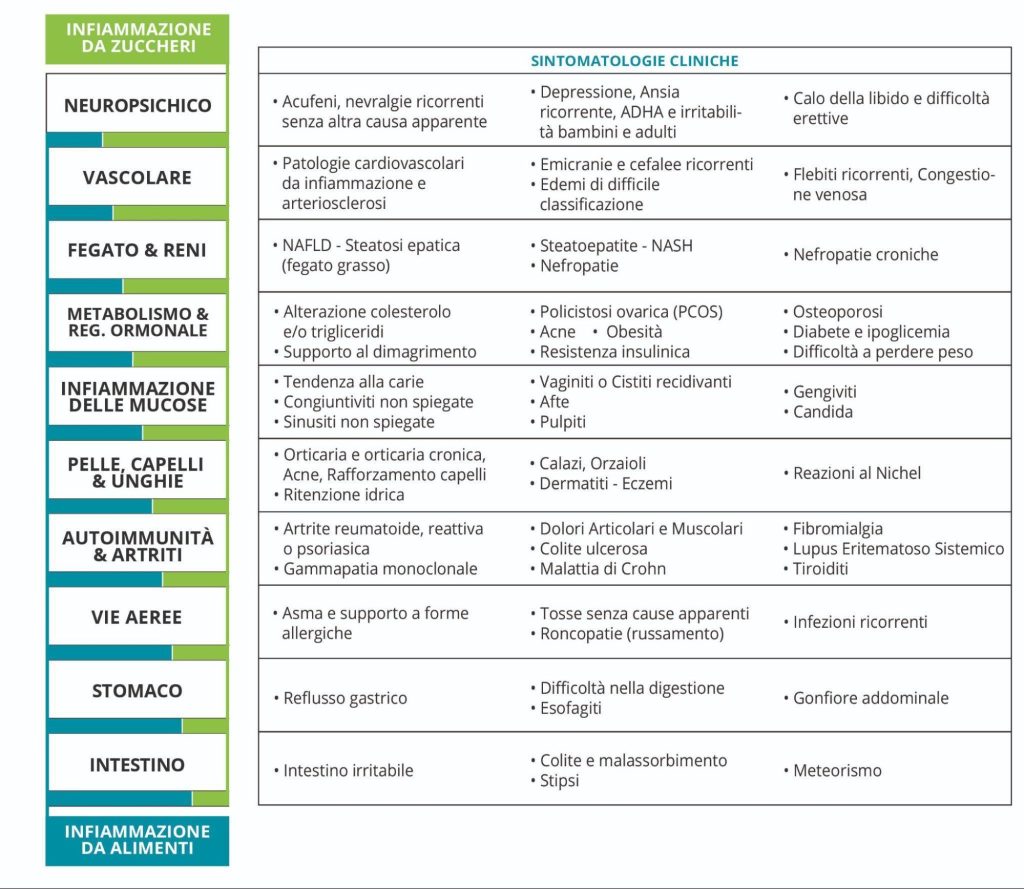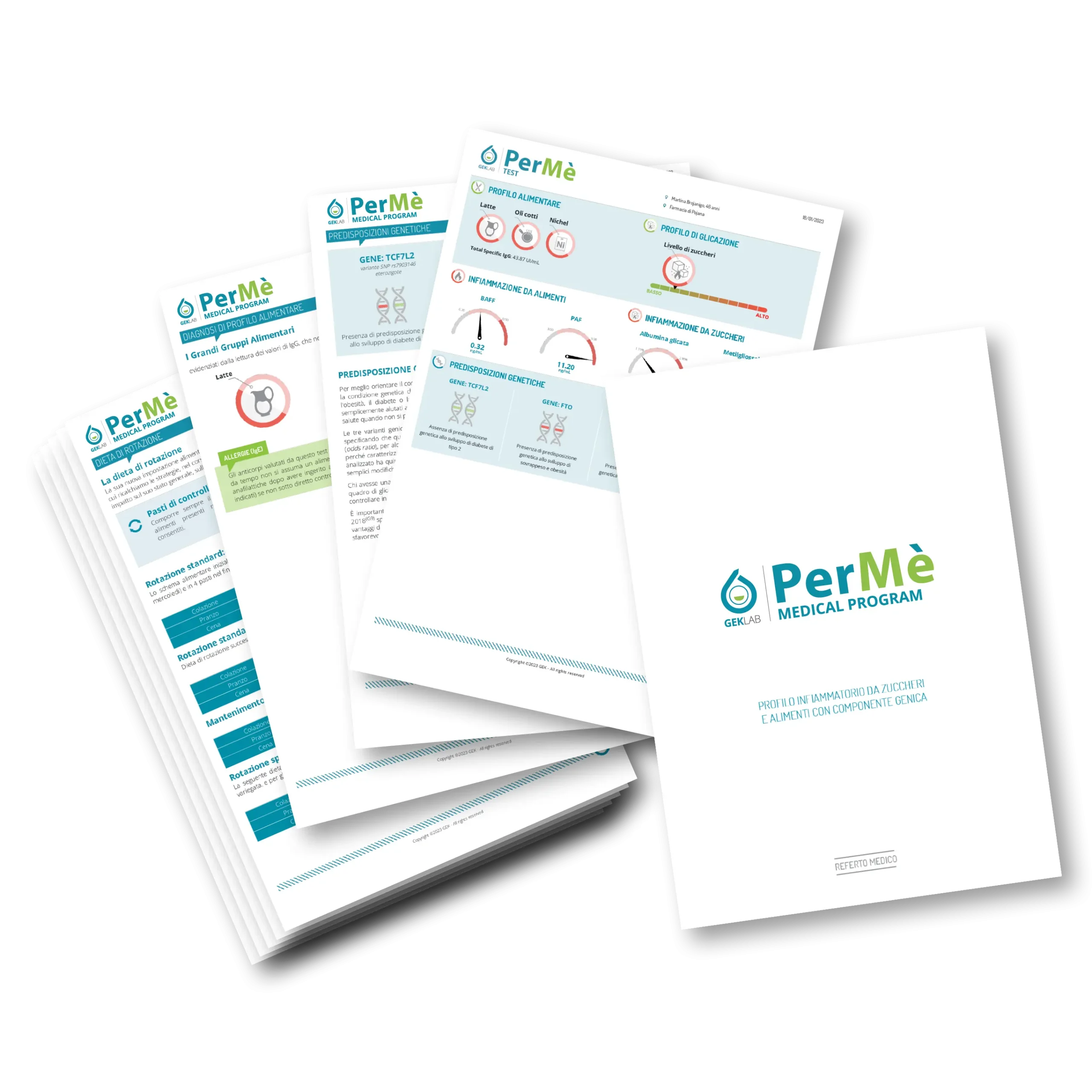
Inflammation, an ancient biological mechanism, plays a crucial role in our health and well-being. It is a physiological process that is, in itself, beneficial—necessary for defending the body against pathogens and infections, and for repairing damaged tissues
The acute inflammatory response that occurs after an injury is crucial for the healing process; however, in order to be effective and not harmful, this response must be short-lived. If the defensive action does not resolve within a brief period, the inflammation fails to “switch off” and persists as a chronic condition, ultimately damaging the body.
Multiple factors—such as the repeated consumption of certain foods, stress, pollution, cigarette smoking, nutritional imbalances, chronic viral infections, and overuse of medications—can trigger or sustain an inflammatory process, leading to a chronic and persistent inflammatory state. This condition underlies various diseases, including metabolic syndrome, non-alcoholic fatty liver disease/non-alcoholic steatohepatitis (NAFLD-NASH), type 2 diabetes (T2DM), cardiovascular diseases, and neuroinflammation.
In many cases, the symptoms of chronic inflammation can affect various organs, systems, and apparatuses, manifesting in a wide range of signs and disorders that are often difficult to trace back to a specific disease.
Poor nutrition plays a crucial role in sustaining and perpetuating inflammation. The repeated consumption of certain foods, combined with an imbalance in macronutrient distribution, can contribute to systemic inflammation. This is why a personalized dietary approach is an effective tool for modulating inflammation and improving overall health.
The different forms of food-related inflammation
In the context of food-related inflammation, two main forms of inflammation can be distinguished, each with its own characteristics and impact on health. Although these forms of food-induced inflammation are different, they often interact with one another, amplifying their negative effects on the body.
Sugar-induced inflammation
It is linked to the excessive consumption of sugars, refined carbohydrates, and metabolically similar substances such as sweeteners and alcohol. High glycemic variability and excessive fluctuations in blood glucose levels—also influenced by how meals are structured—can cause irreversible damage to protein and cellular structures. This phenomenon, known as glycation, leads to increased production of free radicals and a series of inflammatory and/or allergy-like reactions, which are responsible for various, sometimes severe, symptoms and disorders.
To counteract sugar-related damage early on, an innovative product has been developed: the Glyco Medical Program. It measures two biomarkers—Glycated Albumin (GA%) and Methylglyoxal (MGO)—which are useful for timely intervention and monitoring of symptoms and disorders linked to sugar intake, such as lipid and glucose metabolism disorders and insulin resistance. These conditions can evolve into full-blown diseases like diabetes, fatty liver disease, overweight, and obesity, just to name a few.
Food-induced inflammation
It is related to the excessive or repeated intake of one or more food groups, which can stimulate the production of specific immunoglobulin G and the release of inflammatory cytokines. Low-grade inflammation can be measured through the Recaller Medical Program by assessing the levels of two specific inflammatory cytokines, BAFF (B-cell activating factor) and PAF (Platelet activating factor). Inflammation is the common denominator of a multitude of symptoms and inflammatory-based diseases, such as irritable bowel syndrome, inflammatory bowel diseases, autoimmune conditions, and more.
The Recaller Medical Program was developed to measure the level of inflammation present in the body and identify the personal dietary profile—i.e., to determine which food groups should be reduced in consumption and weekly frequency. This tool can help personalize nutritional recommendations and promote a patient-centered therapeutic approach aimed at controlling inflammation.
A study published in Nutrients confirmed the importance of food-specific immunoglobulin G in determining the main food groups for the European population, thus providing further scientific support for this personalized approach.
Genes are not your destiny, but knowing them is helpful.
Our DNA contains the genetic heritage inherited from our ancestors and is in constant dialogue with the surrounding environment. This dialogue can influence our genetic predispositions through biochemical modifications induced by factors such as physical activity and dietary habits. The concept of epigenetics suggests that we can influence the expression of our genes, and thus our health destiny, through lifestyle choices, including diet.
Identifying a genetic predisposition to conditions such as obesity, diabetes, or fatty liver disease does not mean a sentence to the illness, but rather an increased risk of developing it. However, this awareness can be a powerful motivator for adopting a proactive and preventive approach to one’s health. By using this genetic information as a guide, it is possible to strategically adapt dietary habits and lifestyle choices to mitigate the risks associated with these predispositions.
A study published in the British Medical Journal in 2018 highlighted that individuals with a genetic predisposition to obesity benefit more from targeted dietary interventions. This further underscores the importance of knowing one’s genetic background and using it as a guide to make dietary and behavioral choices that promote long-term health and well-being.
Inflammation and nutrition: a constant interaction between health and disease.
Throughout life, each of us experiences inflammatory phenomena that vary in symptoms and duration. Fortunately, today we can measure inflammation in a simple way, just as we measure fever with a thermometer. Knowing the levels of inflammation, including those related to food, is essential for establishing and restoring immune balance.
It is important to address all possible causes of inflammation simultaneously in many inflammatory conditions and symptoms, also taking into account individual genetic predisposition. In many diseases, inflammation related to the daily or excessively repeated consumption of specific food groups plays a significant role and must be addressed alongside inflammation resulting from the excessive intake of sugars and related substances.

A wide range of disorders and diseases can be linked to food and sugar-induced inflammation, affecting various systems and organs:
Metabolic and hormonal disorders, including diabetes, forms of hypoglycemia, difficulties in weight loss, obesity, issues related to insulin resistance, polycystic ovary syndrome (PCOS), and alterations in cholesterol and triglyceride levels, along with hyperuricemia, are common characteristics of metabolic syndrome.
Inflammation of the mucous membranes, including all forms of candidiasis, recurrent vaginitis and cystitis, gingivitis, pulpitis, and recurrent canker sores (a typical area where both food-related and sugar-related inflammation act), tendency to develop cavities, and all eye-related conditions such as unexplained conjunctivitis, keratitis, or blepharitis. The same applies to sinusitis with no apparent cause.
Autoimmunity and arthritis. These are diseases in which the action of inflammatory cytokines such as BAFF can already be a cause, but the symptoms may also be exacerbated by underlying inflammation related to sugar. This group of diseases includes all thyroid diseases (including Hashimoto’s and Basedow’s diseases), autoimmune diseases such as lupus, scleroderma, and undifferentiated connective tissue diseases, various forms of arthritis (rheumatoid, psoriatic, and reactive), inflammatory arthritis, and fibromyalgia. Autoimmune manifestations also include Crohn’s disease and ulcerative colitis.
Respiratory disorders related to allergies or inflammation. This group of disorders includes snoring (also known as ronchopathy), rhinitis, asthma, chronic cough with no apparent cause, and recurrent infections.
Support to control the effects of chemotherapy. Numerous studies show how an anti-inflammatory diet, possibly combined with short-term fasting, can be helpful in better supporting the body during chemotherapy, reducing side effects and enhancing its effectiveness.
Scientific evidence demonstrating the strong link between inflammation and various diseases is constantly increasing. Lifestyle changes, including dietary choices, are often the first recommended intervention in many international guidelines for the treatment of these conditions.
Moreover, it is important to consider that not only diseases can benefit from a personalized nutrition approach, but also non-pathological situations.
Pregnancy: High levels of inflammation detectable by BAFF during the first trimester of pregnancy may already indicate the development of pregnancy-related hypertension in the third trimester. Additionally, measuring glycation biomarkers in the first trimester can also allow for early assessment of gestational diabetes.
Sports and Athletic Performance: Elite and amateur athletes can gain significant benefits from studying inflammation related to sugars and foods. Clinical practice shows a reduction in non-traumatic injuries, as well as improvements in performance and the ability to tolerate higher training loads.
Overweight and Obesity: In obese and overweight individuals, the cytokine BAFF is closely linked to insulin resistance, as it facilitates fat accumulation. Additionally, high levels of Methylglyoxal (MGO) reflect excessive fluctuations in blood sugar due to the intake of glucose, fructose, or sweeteners, which also promote weight gain.
Excessive thinness: Like overweight, excessive thinness is a risk factor for many diseases. It may sometimes be caused by malabsorption in the intestines, leading to insufficient nutrient absorption. This aspect is quite common when there is inflammation in the digestive tract, which can be modulated through a personalized diet.a.
Cognitive performance: everyone should follow a personalized diet during periods of intense work activity, before exams, or during periods of high cognitive demands. The same nutritional conditions that enhance muscle performance also support the proper functioning of the nervous system, optimizing concentration, effort, and mental attention.
Reduce the speed of aging: Inflammation produces reactive oxygen species (ROS) that significantly contribute to the hardening of elastic fibers, tissue sclerosis, and general aging of the body. Controlling various forms of inflammation can slow down the signs of aging and age-related disorders.
General nutritional principles
The “Healthy Eating Plate” proposed by the Harvard School of Public Health in 2011 emphasizes the importance of proteins and the choice of whole grains over refined ones, without focusing on calorie counting. These guidelines are crucial, but on their own, they do not guarantee optimal well-being. It is essential to integrate them with a personalized diet that takes into account individual variability, genetics, and lifestyle.
Inflammatory stimuli can arise from the repeated consumption of certain foods or the daily intake of various types of sugars (fructose, glucose, polyols, or alcohol, which follow the same metabolic pathways). In turn, inflammation, even when related to food, can trigger and sustain various diseases. Sometimes, this phenomenon occurs subclinically, without any obvious symptoms.
For example, people with altered sugar sensitivity may experience inflammatory effects such as fatigue or sleep disturbances due to an individual excess of fructose (a sugar also found in fruit).
Misurare e conoscere questi aspetti, che differiscono da persona a persona, permette a medici e professionisti della salute di gestire consapevolmente e scientificamente l’approccio nutrizionale più adatto.
Edited by The Scientific Editorial Team GEK Lab





